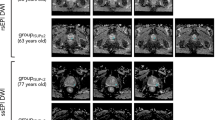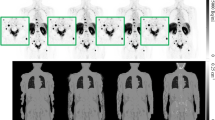Abstract
Prostate specific membrane antigen (PSMA) positron emission tomography/computed tomography (PET/CT) imaging provides a tremendously exciting frontier in visualization of prostate cancer (PCa) metastatic lesions. However, accurate segmentation of metastatic lesions is challenging due to low signal-to-noise ratios and variable sizes, shapes, and locations of the lesions. This study proposes a novel approach for automated segmentation of metastatic lesions in PSMA PET/CT 3D volumetric images using 2D denoising diffusion probabilistic models (DDPMs). Instead of 2D trans-axial slices or 3D volumes, the proposed approach segments the lesions on generated multi-angle maximum intensity projections (MA-MIPs) of the PSMA PET images, then obtains the final 3D segmentation masks from 3D ordered subset expectation maximization (OSEM) reconstruction of 2D MA-MIPs segmentations. Our proposed method achieved superior performance compared to state-of-the-art 3D segmentation approaches in terms of accuracy and robustness in detecting and segmenting small metastatic PCa lesions. The proposed method has significant potential as a tool for quantitative analysis of metastatic burden in PCa patients.
Access this chapter
Tax calculation will be finalised at checkout
Purchases are for personal use only
Similar content being viewed by others
References
Bubendorf, L., Schöpfer, A., Wagner, U., Sauter, G., Moch, H., Willi, N., Gasser, T.C., Mihatsch, M.J.: Metastatic patterns of prostate cancer: an autopsy study of 1,589 patients. Human pathology 31(5), 578–583 (2000)
Duffy, M.J.: Biomarkers for prostate cancer: prostate-specific antigen and beyond. Clinical Chemistry and Laboratory Medicine (CCLM) 58(3), 326–339 (2020)
Dzikunu, O., Ahamed, S., Toosi, A., Harsini, S., Benard, F., Rahmim, A., Uribe, C.: A 3d unet for automated metastatic lesions detection and segmentation from psma-pet images of patients with biochemical recurrence prostate cancer (2024)
Fendler, W.P., Eiber, M., Beheshti, M., Bomanji, J., Ceci, F., Cho, S., Giesel, F., Haberkorn, U., Hope, T.A., Kopka, K., et al.: 68 ga-psma pet/ct: Joint eanm and snmmi procedure guideline for prostate cancer imaging: version 1.0. European journal of nuclear medicine and molecular imaging 44, 1014–1024 (2017)
Freedland, S.J., Presti Jr, J.C., Amling, C.L., Kane, C.J., Aronson, W.J., Dorey, F., Terris, M.K., Group, S.D.S., et al.: Time trends in biochemical recurrence after radical prostatectomy: results of the search database. Urology 61(4), 736–741 (2003)
Harsini, S., Wilson, D., Saprunoff, H., Allan, H., Gleave, M., Goldenberg, L., Chi, K.N., Kim-Sing, C., Tyldesley, S., Bénard, F.: Outcome of patients with biochemical recurrence of prostate cancer after psma pet/ct-directed radiotherapy or surgery without systemic therapy. Cancer Imaging 23(1), 27 (2023)
Haupt, F., Dijkstra, L., Alberts, I., Sachpekidis, C., Fech, V., Boxler, S., Gross, T., Holland-Letz, T., Zacho, H.D., Haberkorn, U., et al.: 68 ga-psma-11 pet/ct in patients with recurrent prostate cancer-a modified protocol compared with the common protocol. European journal of nuclear medicine and molecular imaging 47, 624–631 (2020)
Ho, J., Jain, A., Abbeel, P.: Denoising diffusion probabilistic models. Advances in neural information processing systems 33, 6840–6851 (2020)
Hudson, H.M., Larkin, R.S.: Accelerated image reconstruction using ordered subsets of projection data. IEEE transactions on medical imaging 13(4), 601–609 (1994)
Jafari, E., Zarei, A., Dadgar, H., Keshavarz, A., Manafi-Farid, R., Rostami, H., Assadi, M.: A convolutional neural network–based system for fully automatic segmentation of whole-body [68ga] ga-psma pet images in prostate cancer. European Journal of Nuclear Medicine and Molecular Imaging pp. 1–12 (2023)
Kostyszyn, D., Fechter, T., Bartl, N., Grosu, A.L., Gratzke, C., Sigle, A., Mix, M., Ruf, J., Fassbender, T.F., Kiefer, S., et al.: Intraprostatic tumor segmentation on psma pet images in patients with primary prostate cancer with a convolutional neural network. Journal of Nuclear Medicine 62(6), 823–828 (2021)
Ma, K., Harmon, S.A., Klyuzhin, I.S., Rahmim, A., Turkbey, B.: Clinical application of artificial intelligence in positron emission tomography: Imaging of prostate cancer. PET clinics 17(1), 137–143 (2022)
Moon, T.K.: The expectation-maximization algorithm. IEEE Signal processing magazine 13(6), 47–60 (1996)
Nichol, A.Q., Dhariwal, P.: Improved denoising diffusion probabilistic models. In: International Conference on Machine Learning. pp. 8162–8171. PMLR (2021)
Polson, L., Fedrigo, R., Li, C., Sabouri, M., Dzikunu, O., Ahamed, S., Rahmim, A., Uribe, C.: Pytomography: A python library for quantitative medical image reconstruction. arXiv preprint arXiv:2309.01977 (2023)
Rousseau, E., Wilson, D., Lacroix-Poisson, F., Krauze, A., Chi, K., Gleave, M., McKenzie, M., Tyldesley, S., Goldenberg, S.L., Bénard, F.: A prospective study on 18f-dcfpyl psma pet/ct imaging in biochemical recurrence of prostate cancer. Journal of Nuclear Medicine 60(11), 1587–1593 (2019)
Soldatov, A., von Klot, C.A., Walacides, D., Derlin, T., Bengel, F.M., Ross, T.L., Wester, H.J., Derlin, K., Kuczyk, M.A., Christiansen, H., et al.: Patterns of progression after 68ga-psma-ligand pet/ct-guided radiation therapy for recurrent prostate cancer. International Journal of Radiation Oncology* Biology* Physics 103(1), 95–104 (2019)
Toosi, A., Harsini, S., Ahamed, S., Yousefirizi, F., Bénard, F., Uribe, C., Rahmim, A.: State-of-the-art object detection algorithms for small lesion detection in psma pet: use of rotational maximum intensity projection (mip) images. In: Medical Imaging 2023: Image Processing. vol. 12464, pp. 771–778. SPIE (2023)
Toosi, A., Harsini, S., Benard, F., Uribe, C., Rahmim, A.: Advanced deep learning-based lesion detection on rotational 2d maximum intensity projection (mip) images coupled with reverse mapping to the 3d pet domain (2023)
Wolleb, J., Sandkühler, R., Bieder, F., Valmaggia, P., Cattin, P.C.: Diffusion models for implicit image segmentation ensembles. In: International Conference on Medical Imaging with Deep Learning. pp. 1336–1348. PMLR (2022)
Xu, Y., Klyuzhin, I., Harsini, S., Ortiz, A., Zhang, S., Bénard, F., Dodhia, R., Uribe, C.F., Rahmim, A., Ferres, J.L.: Automatic segmentation of prostate cancer metastases in psma pet/ct images using deep neural networks with weighted batch-wise dice loss. Computers in Biology and Medicine 158, 106882 (2023)
Acknowledgments
This work was supported by CIHR Project Grant PJT-162216, as well as computational resources provided by Microsoft AI for Health.
Author information
Authors and Affiliations
Corresponding author
Editor information
Editors and Affiliations
Ethics declarations
Disclosure of Interests
The authors have no competing interests to declare that are relevant to the content of this article.
Rights and permissions
Copyright information
© 2025 The Author(s), under exclusive license to Springer Nature Switzerland AG
About this paper
Cite this paper
Toosi, A., Harsini, S., Bénard, F., Uribe, C., Rahmim, A. (2025). How to Segment in 3D Using 2D Models: Automated 3D Segmentation of Prostate Cancer Metastatic Lesions on PET Volumes Using Multi-angle Maximum Intensity Projections and Diffusion Models. In: Mukhopadhyay, A., Oksuz, I., Engelhardt, S., Mehrof, D., Yuan, Y. (eds) Deep Generative Models. DGM4MICCAI 2024. Lecture Notes in Computer Science, vol 15224. Springer, Cham. https://doi.org/10.1007/978-3-031-72744-3_21
Download citation
DOI: https://doi.org/10.1007/978-3-031-72744-3_21
Published:
Publisher Name: Springer, Cham
Print ISBN: 978-3-031-72743-6
Online ISBN: 978-3-031-72744-3
eBook Packages: Computer ScienceComputer Science (R0)





